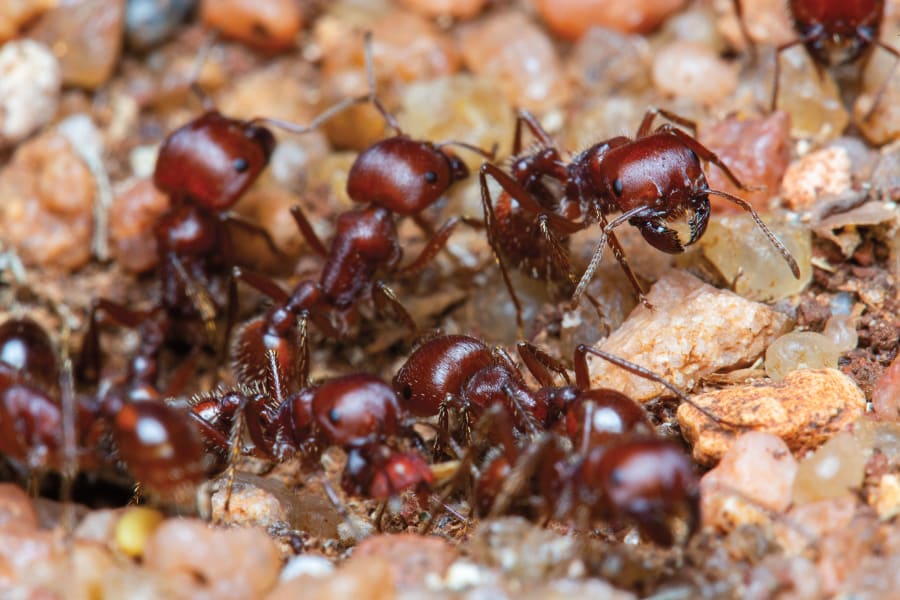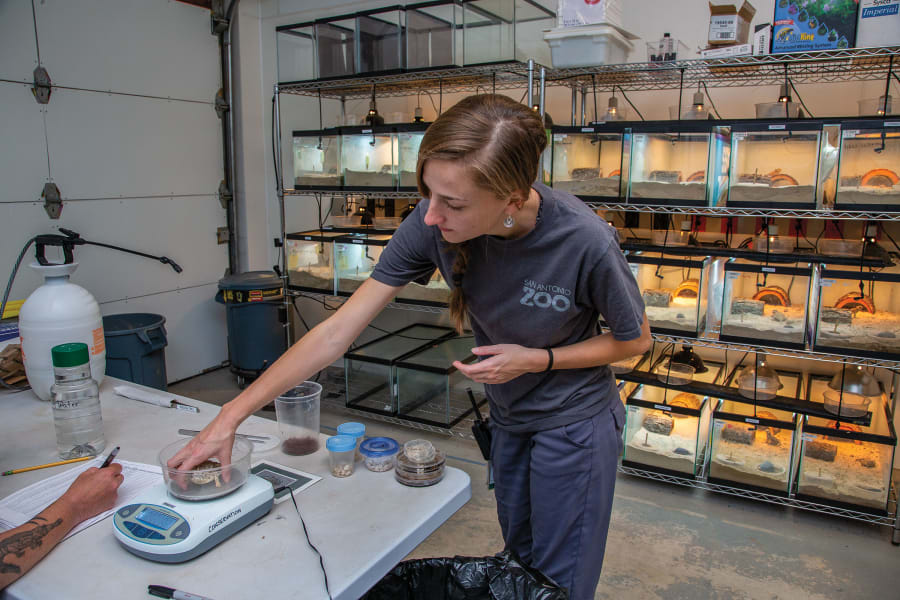This story originally ran on TexasHighways.com.
Once upon a time, you could find Texas horned lizards across much of the state: squat reptiles the color of rusty red and gray gravel, heads crowned with a fan of sharp little horns. Known as “horny toads,” the 5-inch lizards have been immortalized in magnets, murals, and even as TCU’s mascot. They were commonplace, easy to catch, and easy—in their grumpy, frowning way—to fall in love with.
Recommended Videos
“It’s got this cultural attachment in Texas,” says Nathan Rains, a biologist with the Texas Parks and Wildlife Department. “Everyone’s got an affinity for horny toads.”
The biggest and most widespread of North American horned lizards, Texas horned lizards thrive in arid landscapes as far east as Austin, subsisting largely on a diet of red harvester ants. Slow and relatively docile, horned lizards rely on camouflage to keep out of trouble, though when cornered, they can squirt blood from their eyes to startle predators.
At first glance, the Texas horned lizard looks prehistoric, ageless, and tough. But beginning in the 1950s, horned lizards vanished from much of their historical territory. Older Texans “likely have fond memories of abundant horned lizards that aren’t there anymore,” says Andy Gluesenkamp, director of conservation at San Antonio Zoo’s Center for Conservation and Research.
Now, Gluesenkamp and San Antonio Zoo are part of a coalition of zoos, state agencies, and private landowners working on a tricky project: restoring the state’s most famous and finicky reptile to the places it once roamed—and making sure those habitats are ready for their arrival.

San Antonio Zoo’s Horned Lizard Reintroduction Project is housed in a tin-sided warehouse, far from the zoo’s public exhibits. The “lizard factory,” as Gluesenkamp calls it, holds racks of terrariums populated by horned lizards basking under heat lamps, some of them hatchlings still small enough to sit on a nickel. “Most of our animals were plucked up off of the blacktop, where the next car might have been the one that did them in,” Gluesenkamp says. “We’re really trying to minimize the impact to any wild populations, even though we collect only a negligible amount in any given year.”
The lizard’s fragility has been recognized since at least 1977, when the state officially classified horny toads as threatened. The growing sprawl of Texas cities wiped away large swaths of habitat. Rangeland also changed as nonnative grasses like bermuda grass, intended to feed livestock, created impenetrable thickets for the lizards, who live their lives an inch above the ground. Widespread pesticide use and invasive fire ants, meanwhile, devastated the red harvester ant colonies that horned lizards depended on. By the 21st century, horny toads had all but disappeared from East and Central Texas.
In 2007, TCU researchers began studying the diet and genetics of the species. They discovered that the North Texas and South Texas populations of horned lizards are genetically distinct. To preserve genetic diversity, Rains says, conservationists tried to match adults from their specific groups for breeding. In the process, they found that 70-90% of adults normally die every year in the wild.
“That’s a real challenge when you’re trying to reintroduce a species,” Rains says. “There just weren’t enough existing adults to make up for the losses.”
In other words, if the horned lizard was to be returned to its old stomping grounds, conservationists needed a ready supply of new lizards. The Fort Worth Zoo had already begun a breeding program for the northern genetic population in 2000. After years of pilot release programs at the Mason Mountain Wildlife Management Area—33 miles west of Llano—several dozen hatchlings released in 2019 were the first to breed and reproduce on their own. Last September, the zoo released another 204 hatchlings.
When Gluesenkamp left his position as a Texas Parks and Wildlife herpetologist in 2016 to join San Antonio Zoo, he immediately began working on a reintroduction program for the southern genetic population. “Texans love horned lizards as much as they hate all other reptiles combined,” he jokes. “That makes it a lot easier to get people on board with what we’re doing—restoring this really iconic species to our native landscape by managing biodiversity.”
Breeding Texas horned lizards is difficult, however. To survive, the lizards need precise temperature and light regimens, and regular misting. A single lizard can eat as many as 100 harvester ants per day, and they stress easily. Females are capable of laying 30-40 eggs at a time, or having multiple nests in a season, but results in San Antonio so far have been mixed, says Arianna Duffey, a conservation technician at the zoo. One lizard laid 46 eggs, possibly a world record. Another left her eggs scattered haphazardly around the terrarium. Still another dug down to the glass bottom and piled them there.

“We’ve seen it all,” Duffey says. “It’s hard to say why they do what they do—if it’s a matter of being captive versus in the wild, or being a first-time mom versus an experienced one.”
The goal is to produce enough hatchlings to put 100 babies a year on the ground at a given site for three years, with a further 25 a year indefinitely. For that strategy to work, the team also needs to raise the tiny, extremely snackable babies—Gluesenkamp calls them “nature’s popcorn”—to a size where they’ll have a better chance of survival. Since the program’s inception, San Antonio Zoo has managed to hatch over 100 lizards. “There isn’t an owner’s manual for it,” Gluesenkamp says.
The San Antonio project is working primarily with private landowners. Its first hatchling release was 84 lizards on Matthew Winkler’s 2,000-acre Blanco County ranch in October 2020. Last year, the zoo released another 23 lizards on the same land. “As a biologist and as a ranch owner, I like the idea of moving the environment of the ranch back to the way it was 300 years ago,” Winkler says. “My goal is for other ranchers to go, ‘Whoa, this is interesting, maybe we can get involved.’”
Gluesenkamp and Rains say they hear from plenty of landowners eager to participate in horned lizard recovery efforts. But it will be years before the zoos can produce enough babies to make a dent in demand. In the meantime, Gluesenkamp says, landowners can encourage lizard habitat by restoring native grasses, instituting controlled grazing and burning regimens, and fostering existing red harvester ant mounds.
Some ranches still have native populations of horned lizards. At the White Ranch near Mason, ranch manager Brian Wright is delighted by the wild hatchlings that scamper over the red dirt. Here, the babies are common enough that scientists visit to study them.
When he arrived at the White Ranch in 2015, Wright worked with a landowner who focused solely on managing for cattle. Now, Wright manages for wildlife as well, including horned lizards. “The other ranchers think I’m a tree hugger,” he says, beaming through his white beard. “But I’m looking at ecotourism, which I think has the potential to be really marketable. And horned lizards are a big part of that.”
From the January 2022 issue of Texas Highways magazine.



